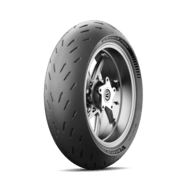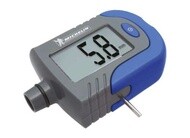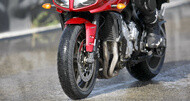
Tips and advice motorbike
Each country has its own legal limit for motorcycle tyre tread depth. What is this limit? What is it for? What are the risks if it is reached? Find the answers in our article.
What is a motorcycle tyre tread depth?
A motorcycle tyre's tread depth is what tells you how worn the tyre is. It is measured vertically from the top of the tread to the base of its grooves.
The more a tyre rolls, the more the rubber erodes. And the closer the erosion is to the base of the grooves, the less the tyre performs (especially in wet conditions). For this reason, a safety threshold has been set by the legislation of each country. Above this threshold, it is considered unsafe to drive.

Where to measure your tyre's tread depth?
The wear pattern on the tyre is not necessarily the same, depending on how you use your motorcycle. In some cases, the centre of the tread will wear faster than the shoulders. In others, it will be the other way around.
Legally, both should be taken into consideration for your and it is the most pronounced wear that should be monitored and which will determine, once the threshold is reached, the need to change your motorcycle tyre.
Motorcycle tyre tread depth when new

Some tyres have a shallow tread when new. In particular track tyres that are also approved for road use.
Although the tread depth is shallower, the legal wear limit is the same as for conventional road tyres.
MICHELIN Power GP, homologated for track and road usage, has a shallow tread when new.
How to check tyre tread depth?
Tyre wear indicators are included in the tyre design, inside the treads. They give a good indication of how worn your tyre is. When the wear is close to the wear indicators, it means that the tyre needs to be changed.
How do I find the wear indicators on the tyre?
Wear indicators are nestled in the hollows of the treads. Since they can be difficult to find, manufacturers usually carve markers into the tread.
Michelin tyres, for example, have little 'Michelin Man' markings on the rubber. They are there to indicate the location of wear indicators.

1 - Identify the Michelin Man symbol
2 - Find the closest motorcycle tyre wear indicator in a main groove
Other tyre brands simply indicate "TWI" for "Tread Wear Indicator" on the tyre to tell you where it is located.
Motorcycle tyre tread depth measurement tool
There is another way to measure the wear of your tyres. Simply buy a special measuring tool from a dealer. By inserting it into the grooves, you can determine the level of wear very precisely.
Michelin has developed a digital tool that combines two functions:
- tyre depth control
- pressure control

All you have to do is place the small needle in a groove and the depth is immediately displayed in millimetres on the digital screen.
To find out the pressure of your tyre, you insert the nozzle into the valve, and it is displayed in bars on the screen.
What’s the legal requirement?
All tyre manufacturers include wear indicators in their tyres with a height of 0.8mm. However, it is important to know that this value is indicative and allows you to know, when the wear level is approaching it, that it is time to change the tyre.
The legal limit varies from country to country.
For example, in France, the legal limit is 1mm, whereas in Germany it is 1.6mm.
In the United Kingdom, the legal limit for motorcycles over 50cc is 1mm across 3/4 of the width of the tread pattern and with visible tread on the remaining 1/4. For motorcycles up to 50cc the law requires that all the grooves of the original tread pattern must be clearly visible.
It is your responsibility to ensure that the wear level of your tyres never passes this legal limit.
Driving over the legal limit carries significant risks
By driving beyond this limit, you would not only be breaking the law. You would also be putting yourself at risk. When you reach this limit, your tyres are less efficient because they have hardly any tread left. In rainy weather, for example, water can no longer drain away and the risk of a fall is therefore high.
Once the treads are worn away, erosion can reach the tyre plies and the carcass can fail, which is a dangerous deterioration for your safety.

When to check the wear level of your tyres?
We recommend that you check the wear level of your tyres every time you check your tyre pressure, which should be done once a month.
What causes tyre wear?
It is important to differentiate between normal tyre wear, which occurs over time through driving, and premature wear, which can lead to an earlier tyre change.
Premature wear can sometimes be avoided in order to preserve your tyres and allow you to enjoy their performance for longer.
Incorrect pressure, for example, can cause more pronounced wear on the centre of the tyre (in the case of over-inflation) or on the shoulders (in the case of under-inflation) and therefore lead to an earlier tyre change. Check your tyre pressure once a month so that it corresponds to that recommended by the manufacturer.
Transmission, fixings or a very sporty driving can also cause premature wear. If you have any doubts, contact a professional.

Search by
Address, City or Postcode
Locate me
Find the right tyre
Enter your Reg, vehicle or tyre size
We're searching for your tire...
Wait few seconds we're processing your photo

